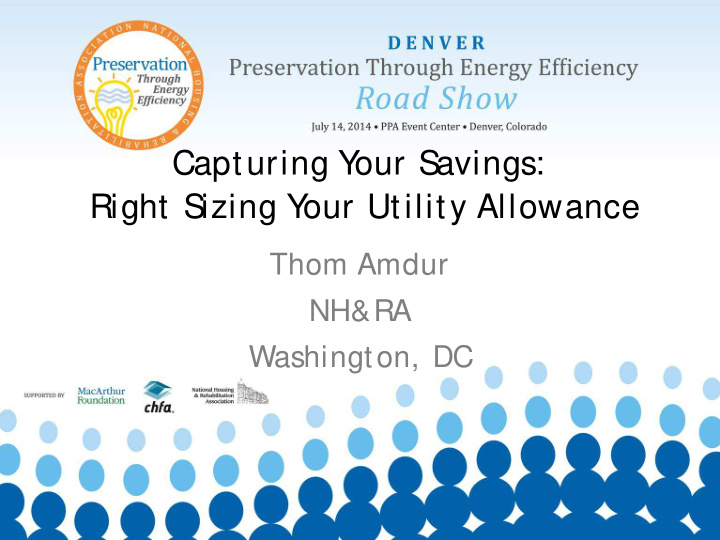



Capturing Y our S avings: Right S izing Y our Utility Allowance Thom Amdur NH&RA Washington, DC
Utility Allowances • Federal housing caps housing costs at 30 percent of the household’s adjusted monthly income • Housing burden is calculated as a combination of rent and utilities • The amount that the household is expected to pay for utilities is the “Utility Allowance” • A utility allowance that is reduced because of energy efficiency benefits both the owner and the resident
IRS Permit 5 LIHTC Utility Allowances Methodologies 1. Local PHA calculates utility allowance, generally using one of the following methodologies: • Consumption-Based Methodology • Engineering-Based Methodology 2. Local utility company calculates utility allowance 3. HFA provides utility allowance 4. HUD Utility Schedule Model 5. Project Specific UA based on an Energy Consumption Model by qualified professional
Energy Efficient Utility Allowances Methodologies • Allow owners to project savings into their underwriting and size a larger loan based on increased cash-flow • Incorporate early into the process to maximize proceeds • Models for consideration: – California Utility Allowance Calculator (CUAC) – Indiana (under development)
Utility Allowances Continued Better Opportunities • LIHTC properties without HUD Rental Assistance or Public Housing Subsidy that are: – Individually metered – Checkmetered / Submetered – Mix-metered • New construction or substantial-rehab • Properties at maximum tax credit rents • Use in conjunction with resident education programs
Utility Allowances Continued Before You Jump In… • If you have project-based rental assistance on the property different rules apply and your HAP payment will be impacted • Can face resident resistance if education and outreach is not sufficient • Make sure you underwrite for upfront and annual UA fees
Additional Utility Allowances Resources NH&RA: http://www.housingonline.com/EnergyFriendlyAfforda bleHousingResources.aspx Enterprise: http://www.enterprisecommunity.com/policy-and- advocacy/issues/green-and-sustainable-housing- and-communities/utility-allowances
Capturing Your Savings: Right Sizing Your Utility Allowance Crystal Bergemann S enior Energy Analyst U.S . Department of Housing and Urban Development Crystal.A.Bergemann@ HUD.gov
Utility Allowance Working Group & Recommendations 1. Provide Increased Flexibility to S et Utility Allowances based on Energy Consumption Models.
Utility Allowance Working Group Recommendations Continued 2. Expand the use of Energy Management/ Energy Benchmarking tools, such as EP A Portfolio Manager in UA S etting and Reviews.
HUD’s Commitment to Benchmarking • HUD spends approximately $6 billion annually on utility bills, with tenants paying billions more directly. • We encourage our owners to take advantage of the EP A ’s free Portfolio Manager Program • In t he next t wo t o f ive years - it may become st andard pract ice f or HUD t o require ut ilit y consumpt ion dat a collect ion and benchmarking. As well, HUD may begin t o require exist ing propert ies t o bring t hemselves up t o a minimum energy ef f iciency st andard, such as Energy S t ar or it s equivalent , upon cont ract renewal t ouch point s.
Utility Allowance Working Group Recommendations Continued 3. Develop Policy Guidance for S etting Utility Allowances in Properties with Installed Renewable Energy.
Renewable Energy Target for Federally Subsidized Housing 100 megawatts of installed renewable capacity on-site at federally subsidized housing by 2020 Triple on-site production on HUD’s Public Housing and Multifamily Assisted properties, USDA Rural Development, and Low Income Housing Tax Credit units expand the renewable energy sector promote climate resilience and cost effective distributed generation in low income housing curb carbon emissions tools like Power Purchase Agreements are making it possible
Better Buildings Challenge Incentive Package for HUD Assisted Owners HUD is developing t he following incent ives t o help address t he market and policy barriers mult ifamily owners experience in improving t he energy and wat er efficiency of t heir propert ies: Management Fee Incentive: Access to Add-on Fees for eligible energy and water efficiency activities. Reserve for Replacement Incentive : Expedited approval for energy and water efficiency capital improvements. Mark to Market Incentive: Incentive Performance Fee increase for meeting specific energy and water efficiency requirements. PRAC Incentive: Allow 202/ 811 PRAC properties to include energy savings associated with energy improvements as an eligible expense to the property budget. Increased distributions: Up to 100 percent for non-profit S ection 8 owners, based upon properties meeting annual energy reduction targets. On-Bill Financing and Repayment Incentive: Invite BBC participants to take part in HUD-approved utility and third party programs. 14
Additional Resources for Better Buildings Challenge Multifamily Partners Ongoing collaboration and technical assistance from HUD and DOE. Referral to government and industry resources. Training for EPA’s Portfolio Manager – a utility data tracking and benchmarking software. Opportunities to network, share best practices, and collaborate with other BBC partners and industry stakeholders. 15
Recommend
More recommend